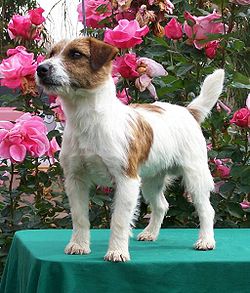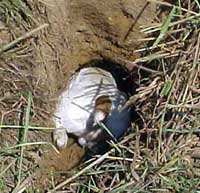|
Home Horses and Dogs | First Posted: Jan, 2010 Jan 21, 2020 | |
"Hunting Parson," Rev. John Russell The Hunting Parson/Reverend John Russell   Jack Russell Terrier and down a fox hole! This article came from Breeds of Dogs "Although a man of the cloth, the 'Hunting Parson,' Rev. John Russell, was a passionate fox hunter of the mid-1800s and pursued the sport until his death at age 88. Fox hunters needed small dogs to roust the foxes who had escaped to ground. Many hunters employed smaller or shorter legged terriers, which had to be carried on horseback to the fox's lair. But the Reverend Jack liked a longer legged type that could follow the hounds on foot. He developed his own strain, based on a crossbred terrier bitch, 'Trump,' which he bought from a milkman. How Russell continued with the breeding program was never recorded, but even modern proponents of the breed admit a certain amount of crossbreeding occurred. First, fighting bull-and-ierrier dogs were used to add the white color (easily differentiated by the hounds from the fox) and increase the aggression and tenacity. Unfortunately, this often resulted in a dog that silently killed the fox underground, thus spoiling the sport of the hunt for the others! Small 'pocket' Beagles were used to temper this hard edge, as well as adding the tendency to give tongue. The result was a dog that was often one thought ahead of the fox. Game to this day, a good Russell Terrier is still capable of going to ground. One owner described how her three JRTs chased a bull raccoon down a drain pipe near her home. When they hadn't emerged by the next morning, she had a backhoe brought in and started digging. The crew cut a ditch, reaching 300 feet, over the next 12 hours, and finally discovered the raccoon backed up against the cellar wall. Not only were the terriers none the worse for the ordeal, they were still jockeying for position with one another to get closest to the prey. It is not unusual for this breed to forego food, water and other creature comforts once it has the whiff of the quarry. Although the Parson never used his dogs for the purpose, the JRT is also a plucky ratter. In 1977, an Englishman and his team of four Jack Russells took three tons of rats out of chicken farms in just one day! Another modern JRT owner gave this practical advice to a writer from Sports Illustrated to pass on to anyone planning to take part in this sport with their dogs: 'If you take your terrier ratting, always wear slacks or breeches tucked either into your Wellingtons or into your socks so that the rats cannot run up your trouser legs or skirt. This happens far more often than one might imagine, and, although it may be excruciatingly funny to the rest of the party, it is no joke for you.' Despite all this emphasis on its ability and desire to fight and kill pests, JRTs are excellent house dogs and children's pets. They have a unique sense of humor, are clean in their habits and are sweet and affectionate to people. They do require plenty of exercise. When there is more than one, they have a tendency to go off hunting on their own if not fenced. The old instincts to get down in the ground may cause some to be passionate diggers. But they are happy companions and their fans are delighted with them. The Jack Russell Terrier has its own registering body in both Britain and the USA, but in neither country is there much desire for formal recognition of the breed. Owners prefer the unrefined nature of their dog. They worry about novice owners caring more about show points and good looks, allowing a loss of the working characteristics that have been so painstakingly kept over the years. A typical opinion is stated: 'If these terriers ever become soft-bred show dogs, John Russell will turn over in his grave.' In fact, there is a reverse snob appeal about this breed, due to the fact that they do not want to be AKC recognized. This, in addition to the fact that they possess an affinity for horses, has made them a popular addition to many horse farms and estates of the wealthy, especially on the East Coast. In all physical characteristics, form follows function. The size of a good Jack Russell should be about the same as that of a fox; if the fox can go down the hole, then the terrier should be able to follow without difficulty. The standard demands that the chest be narrow enough to be spanned by two hands behind the shoulder blades. Chests that are chunkier create a dog that can be stuck in the hole! The docked tail of an adult specimen should end up about four inches, just enough length to be able to grab in order to extract the dog from the burrow. The predominance of white differentiates him from the fox. Most of the larger sized dogs sport the rough or broken coat (similar to a smooth, with fuller hair on the legs and a bit of wiry hair on the chin creating a beard), while the shorter legged variety, carrying more of the cross to the pocket beagle, are more often smooths. Although they often live to 16 years as a house pet, their fearless nature tends to shorten their lifespan in the country. One breeder estimates the average lifespan on a farm to be only six years." Parson John Russell's Obituary from the Swimbridge Parochial NewsletterRev. John Russell The illness from which the Rev. John Russell had long been suffering, ended fatally on Saturday the 28th of April. The sad event had been expected, and many who had seen him in our Parish Church on Sunday, 4th. of March, realized the fact that the end could not be very far off. Mr. Russell was born at Dartmouth, on December 21st 1795, his father just previously, having been appointed to the Rectory of Iddesleigh, near Okehampton. He was the first sent to school at Plympton, and sometime after he was removed to Blundell's School at Tiverton, where he succeeded in obtaining an exhibition of £30 a year, tenable at Exeter College, Oxford. Soon after having taken his degree at Oxford, Mr Russell was nominated to the curacy of Georgenympton, was ordained deacon in 1819, and priest in the following year by the Bishop (Pelham) of Exeter. That Mr. Russell entered on the work of the ministry with a due sense of the sacred office, and of his own responsibility by many, who have only heard of his fame in the hunting field, But, if a readiness to visit the sick and weary; to relive the wants of his poorer brethren, however poor himself; to preach God's word earnestly; to plead in many a neighbouring pulpit, the cause of hospitals and kindred institutions - if such things be of good report, and carry any weight, no human being can say of him - life had been altogether that of an unprofitable servant. Soon after his appointment to George Nympton, he became Curate of South Molton in addition. Towards the end of 1825, or the beginning of 1826, an event, affecting the happiness of his life happened, namely, his marriage with Miss Penelope Bury, daughter of Admiral Bury of Dennington. In the Autumn of 1874, a heavy sorrow awaited Mr. Russell - the heaviest he had known through life - by the serious illness of Mrs. Russell, and her subsequent death on New Years Day, 1875. In a letter to an old Curate of his, he alludes thus to the event: "I am at home again, though it no longer seems like home to me; for there is a vacant chair in every room, never again to be filled by her, the dear old soul, to whom I was united forty-nine years ago, come Sunday." Mr Russell removed to Swymbridge, after six years residence at Iddesleigh, in the year 1832. In the following year the Perpetual Curacy of Swymbridge and Landkey became vacant, to which he was appointed, remaining in charge for nearly fifty years. Of his consideration and kindheartedness an instance is given in his treatment of the wandering tribes of gipsies, that were accustomed to sojourn awhile on the waste spots in his parish. Instead of persecuting them as trespassers by impounding their donkies, compelling them to strike their tents at a moment's notice, driving them and their children from pillar to post and treating them more like wolves than human beings, he never failed to befriend and protect them when-ever he though they were unfairly used. In return for this kindness they took active steps to protect his house when they had very good reason to believe it was threatened by a gang of thieves. It was also recorded that when the King of Gipsies Edward Boswell, fell ill, and felt that his earthly hours were drawing to a close, he expressed a last wish that a charm he had long worn and prized greatly - a Spanish Silver Coin, of the date of Charles III - should be given to Mr. Russell, in token of the sympathy he had ever shown to him and his tribe. At the same time he requested that he might be buried in Swymbridge Churchyard, and by Mr. Russell himself. It is quite unnecessary that any attempt should be made at a description of Mr. Russell's characteristics. The best qualities of a kindly hearted man were present in him in a remarkable degree, and wherever his name has become familiar it has always associated with all that is honourable and chivalrous, and withal with recollections of innumerable kind attentions to those with whom his position brought him into close contact. By the poor he was always looked upon as one to whom their concerns were of importance, and who was near to them in heart in the troubles of their lot; and by the rich, from the Prince of Wales downwards, he was always welcomed, as much on account of the air of cheerfulness which always marked his presence; as for the wonderful number of anecdotes with which he sustained the life of the conversation in which he was an animated partaker. By his death the poor and lowly lose a kindly helper, while those in other stations will undoubtedly feel that in their circles a blank, which will never be filled up, has been created. The change to the Black Torrington Rectory, brought about by the force of circumstances, he never ceased to regret. It could not be otherwise after having forty eight years of his life here. After three short years in his new home he was brought back here to be laid by the side of her who for nearly fifty years shared his joys and sorrows. The enormous crowd that gathered from all parts of the country to his funeral testified to the esteem in which he was held by all classes of society. They felt that there lay one dead whose kindly actions, whose cheery words and genial smile had endeared him to them: and so they stood round his grave and paid him the last tribute of love. Any may we say that the lesson his life teaches is this: To be kind one towards another, to be ready to assist each other in the many trials and difficulties of life, and to try and lead honest upright, temperate live. |